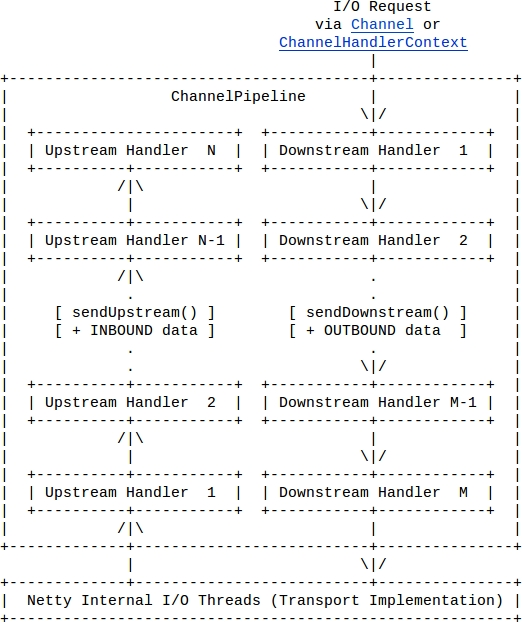netty ChannelPipeline流处理源码详细分析
netty 官网api,在介绍pipeline处理流的时候,给了一些例子和图片介绍。
以来证明 upstreamHandle和downstreamHandler流处理的顺序。
光看例子和结论,说实话很难理解,干脆不如自己动手,debug。
如图。

下面是例子
public class Server {
public static void main(String args[]) {
ServerBootstrap bootsrap = new ServerBootstrap(
new NioServerSocketChannelFactory(Executors
.newCachedThreadPool(), Executors.newCachedThreadPool()));
bootsrap.setPipelineFactory(new PipelineFactoryTest());
bootsrap.bind(new InetSocketAddress(8888));
}
public class PipelineFactoryTest implements ChannelPipelineFactory {
@Override
public ChannelPipeline getPipeline() throws Exception {
ChannelPipeline pipeline = Channels.pipeline();
pipeline.addLast("1", new UpstreamHandlerA());
pipeline.addLast("2", new UpstreamHandlerB());
pipeline.addLast("3", new DownstreamHandlerA());
pipeline.addLast("4", new DownstreamHandlerB());
pipeline.addLast("5", new UpstreamHandlerX());
return pipeline;
}
}
public class UpstreamHandlerA extends SimpleChannelUpstreamHandler {
@Override
public void messageReceived(ChannelHandlerContext ctx, MessageEvent e)
throws Exception {
Channel ctxchannel = ctx.getChannel();
Channel echannel = e.getChannel();
System.out.println(ctxchannel.equals(echannel));//handle和event共享一个channel
System.out.println("UpstreamHandlerA.messageReceived:" + e.getMessage());
ctx.sendUpstream(e);
}
@Override
public void exceptionCaught(ChannelHandlerContext ctx, ExceptionEvent e) {
System.out.println("UpstreamHandlerA.exceptionCaught:" + e.toString());
e.getChannel().close();
}
public class UpstreamHandlerB extends SimpleChannelUpstreamHandler {
@Override
public void messageReceived(ChannelHandlerContext ctx, MessageEvent e)
throws Exception {
System.out
.println("UpstreamHandlerB.messageReceived:" + e.getMessage());
ctx.sendUpstream(e);
}
@Override
public void exceptionCaught(ChannelHandlerContext ctx, ExceptionEvent e) {
System.out.println("UpstreamHandlerB.exceptionCaught:" + e.toString());
e.getChannel().close();
}
}
public class UpstreamHandlerX extends SimpleChannelUpstreamHandler {
@Override
public void messageReceived(ChannelHandlerContext ctx, MessageEvent e)
throws Exception {
System.out.println("UpstreamHandlerX.messageReceived:"+e.getMessage());
e.getChannel().write(e.getMessage());
}
@Override
public void exceptionCaught(ChannelHandlerContext ctx, ExceptionEvent e) {
System.out.println("UpstreamHandlerX.exceptionCaught");
e.getChannel().close();
}
}
public class DownstreamHandlerA extends SimpleChannelDownstreamHandler {
public void handleDownstream(ChannelHandlerContext ctx, ChannelEvent e)
throws Exception {
System.out.println("DownstreamHandlerA.handleDownstream");
super.handleDownstream(ctx, e);
}
}
public class DownstreamHandlerB extends SimpleChannelDownstreamHandler {
public void handleDownstream(ChannelHandlerContext ctx, ChannelEvent e)
throws Exception {
System.out.println("DownstreamHandlerB.handleDownstream:");
super.handleDownstream(ctx, e);
}
}
client:
public class AppStoreClinetBootstrap { public static void main(String args[]){ ExecutorService bossExecutor = Executors.newCachedThreadPool(); ExecutorService workerExecutor = Executors.newCachedThreadPool(); ChannelFactory channelFactory = new NioClientSocketChannelFactory(bossExecutor, workerExecutor); ClientBootstrap bootstarp = new ClientBootstrap(channelFactory); bootstarp.setPipelineFactory(new AppClientChannelPipelineFactory()); ChannelFuture future = bootstarp.connect(new InetSocketAddress("localhost", 8888)); future.awaitUninterruptibly(); if(future.isSuccess()){ String msg = "hello word"; ChannelBuffer buffer = ChannelBuffers.buffer(msg.length()); buffer.writeBytes(msg.getBytes()); future.getChannel().write(buffer); } } }
public class AppClientChannelPipelineFactory implements ChannelPipelineFactory{
public ChannelPipeline getPipeline() throws Exception {
ChannelPipeline pipeline = pipeline();
//pipeline.addLast("encode", new StringEncoder());
pipeline.addLast("handler", new AppStoreClientHandler()); return pipeline;
}
}
public class AppStoreClientHandler extends SimpleChannelUpstreamHandler {
private static Logger log = Logger.getLogger(AppStoreClientHandler.class);
@Override
public void messageReceived(ChannelHandlerContext ctx, MessageEvent e) throws Exception {
}
@Override
public void exceptionCaught(ChannelHandlerContext ctx, ExceptionEvent e) throws Exception {
// TODO Auto-generated method stub super.exceptionCaught(ctx, e);
}
}
上面的例子证明了。updatestream 和downstream的传播顺序。
Upstream: 1 ->2 ->5 顺序处理
Downstream: 4 ->3 逆序处理
========================================================
好了到此打住。开始分析源码为什么这样?
在servers端,bind后,
如果client 没有请求,那么servers端会一直处于循环状态。直到有新的client 连接就开始激活
代码如
NioServerSocketPipelineSinkle class
......................
public void run() {
final Thread currentThread = Thread.currentThread();
channel.shutdownLock.lock();
try {
for (;;) {
try {
if (selector.select(1000) > 0) {
selector.selectedKeys().clear();
}
//启动servers后如果clent没有请求,则这个一直循环
SocketChannel acceptedSocket = channel.socket.accept();
if (acceptedSocket != null) {
registerAcceptedChannel(acceptedSocket, currentThread);
}
......................................
有client请求后被激活开始注册,如下代码
private void registerAcceptedChannel(SocketChannel acceptedSocket, Thread currentThread) {
try {
ChannelPipeline pipeline =channel.getConfig().getPipelineFactory().getPipeline();
NioWorker worker = nextWorker();
worker.register(new NioAcceptedSocketChannel(
channel.getFactory(), pipeline, channel,
NioServerSocketPipelineSink.this, acceptedSocket,
worker, currentThread), null);
} catch (Exception e) {
logger.warn(
"Failed to initialize an accepted socket.", e);
try {
acceptedSocket.close();
} catch (IOException e2) {
logger.warn(
"Failed to close a partially accepted socket.",
e2);
}
}
}
红色部分。拿到 pipeline所有的handle ,即 PipelineFactoryTest 类中ChannelPipeline,具体由NIOWORK去处理I/O
重点在于pipeline.addlast方法
public synchronized void addLast(String name, ChannelHandler handler) {
if (name2ctx.isEmpty()) {
init(name, handler);
} else {
checkDuplicateName(name);
DefaultChannelHandlerContext oldTail = tail;
DefaultChannelHandlerContext newTail = new DefaultChannelHandlerContext(oldTail, null, name, handler);
callBeforeAdd(newTail);
oldTail.next = newTail;
tail = newTail;
name2ctx.put(name, newTail);
callAfterAdd(newTail);
}
}
DefaultChannelHandlerContext 就是链表结构,通过next和prev用来存放各种upstreamhandler和downstreamhandle(这个地方是重点),
由于upstream是专门负责接收数据的,所以当客户端有数据请求时,PipelineFactoryTest类中的upstreamhandle就依次顺序传递。
下面的代码说明了,为什么是顺序传递。如果大家细心的的话,可以看到 PipelineFactoryTest 3个upstreamhandle里面都有一个
ctx.sendUpstream(e);(ChannelHandlerContext 就是各种handler的上下文)
这个方法,就是上一个upstreamhandler负责将事件传递给下一个 upstreamhandler (典型的责任链模式)
代码如下
public void sendUpstream(ChannelEvent e) {
DefaultChannelHandlerContext next = getActualUpstreamContext(this.next);
if (next != null) {
DefaultChannelPipeline.this.sendUpstream(next, e);//下一个upstreamhandle立马触发
}
}
DefaultChannelHandlerContext getActualUpstreamContext(DefaultChannelHandlerContext ctx) {
if (ctx == null) {
return null;
}
DefaultChannelHandlerContext realCtx = ctx;
while (!realCtx.canHandleUpstream()) {
realCtx = realCtx.next;
if (realCtx == null) {
return null;
}
}
return realCtx;
}
前面讲了DefaultChannelHandlerContext是链表结构存放了不少handler,因此所有的upstreamhandle都在这里取。然后继续事件传递。
因为所有的upstreamhandle是共用一个event,他们同时也共用一个channelbuffer。这种模式和责任链很相像,也可以来处理来用做filter处理
写到这里,就很容易理解了,netty里面 各种encode(downstreamhandle)和decode(upstreamhandle)。
同理downstreamhandle分析
UpstreamHandlerX类有个e.getChannel().write(e.getMessage())方法。这里会触发一个DownstreamMessageEvent,从而找到对应的DownstreamHandlerA
downA-downB的传递 是通过super.handleDownstream(ctx, e);来完成的。
public ChannelFuture write(Object message) {
return Channels.write(this, message);
}
public static ChannelFuture write(Channel channel, Object message, SocketAddress remoteAddress) {
ChannelFuture future = future(channel);
channel.getPipeline().sendDownstream(
new DownstreamMessageEvent(channel, future, message, remoteAddress));
return future;
}
写这篇blog思维跳跃比较大。摸索了一天,挺有收获的。记录下



